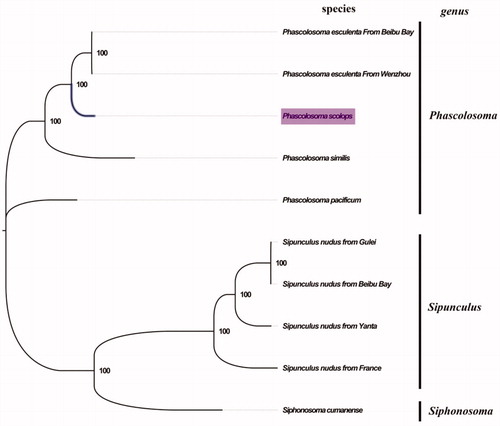Abstract
Phascolosoma is one of the most important genera of Sipuncula, many species of which including P. scolops are economic important species in the fishery of southeast China. However, the synonym and misidentification of species in Phascolosoma have been reported repeatedly. Here, we report the complete mitochondrial genome sequence of P. scolops. The mitogenome has 15,515 base pairs and made up of total of 38 genes (13 protein-coding, 23 transfer RNAs and 2 ribosomal RNAs), and a putative control region. The complete mitogenomes of P. scolops will contribute to further phylogenetic and taxonomic study in the genus Phascolosoma.
Sipunculans (known as peanut worms) are an ancient group of exclusively marine benthonic animals which contain about 150 species with a global distribution and a fossil record of dates back to the Early Cambrian (Lemer et al. Citation2015). Phascolosoma is one of the most important genera of Sipuncula, many species of which are economically important due to valuable nutrition of delicious seafood and valuable ingredients of traditional medicines. However, the synonym and misidentification of species in Phascolosoma have been reported repeatedly (Cutler and Cutler Citation1983). Mitochondrial genome is an excellent molecular marker for taxonomy identification and phylogenetic analysis, but adequate mitogenome information about the genus Phascolosoma is still limited (Zhong et al. Citation2020). Here, we report the complete mitochondrial genome sequence of Phascolosoma scolops, which will provide a better insight into taxonomic classification and phylogenetic relationship of Phascolosoma.
The tissue samples of P. scolops from 3 individuals was collected from Beibu Bay, China (Beihai, 21.046257 N, 109.155277E), and the whole body specimens (#GG0083) were deposited at Marine biological Herbarium, Guangxi Institute of Oceanology, Beihai, China. The total genomic DNA was extracted from the muscle of the specimens using an SQ Tissue DNA Kit (OMEGA, Guangzhou, China) following the manufacturer’s protocol. DNA libraries (350 bp insert) were constructed with the TruSeq NanoTM kit (Illumina, San Diego, CA) and were sequenced (2 × 150bp paired-end) using HiSeq platform at Novogene Company, China. Mitogenome assembly was performed by MITObim (Hahn et al. Citation2013). The complete mitogenome of Phascolosoma similis (GenBank accession number: MN813482) was chosen as the initial reference sequence for MITObim assembly. Gene annotation was performed by MITOS (http://mitos2.bioinf.uni-leipzig.de/).
The complete mitogenome of P. scolops from Beibu Bay was found to be 15,515 bp in length (GenBank accession number: MT239480), including the usual set of gene for mitogenome except for extra threonine tRNA which consisting of 13 protein-coding, 23 tRNA and 2 rRNA genes, and a putative control region. The overall base composition of the mitogenome was estimated to be A 32.3%, T 33.1%, C 21.6% and G 13.0%, with a high A + T content of 65.4%, which is slightly higher than Phascolosoma similis (63.5%) (Zhong et al. Citation2020). The mitogenomic phylogenetic analyses showed that P. scolops was first clustered with P. esculenta and then with P. similis in the genus Phascolosoma clade (), which indicated the close relationship between P. scolops and P. esculenta. The taxonomic classification of Phascolosoma using morphological characteristics (Li Citation1989) was consistent with our phylogenetic analyses, which will contribute to further phylogenetic and taxonomic study in the genus Phascolosoma.
Figure 1. Phylogenetic tree in Sipuncula. The complete mitogenomes is downloaded from GenBank and the phylogenic tree is constructed by maximum-likelihood method with 100 bootstrap replicates. The bootstrap values were labeled at each branch nodes. The gene's accession number for tree construction is listed as follows: Phascolosoma pacificum (NC_031412), Phascolosoma similis (MN813482), Phascolosoma esculenta From Wenzhou(NC_012618), Phascolosoma esculenta From Beibu Bay (MG873458), Sipunculus nudus from France (NC_011826), Sipunculus nudus from Yanta (KP751904), Sipunculus nudus from Gulei (KJ754934), Sipunculus nudus from Beibu Bay (MG873457), and Siphonosoma cumanense (MN813483).

Disclosure statement
The authors declare that they have no conflict of interest.
Data availability
The data that support the findings of this study are openly available in [National Center for Biotechnology Information] at [https://www.ncbi.nlm.nih.gov/nuccore], reference number [MT239480].
Additional information
Funding
References
- Cutler E, Cutler N. 1983. An examination of the Phascolosoma subgenera Antillesoma, Rueppellisoma and Satonus (Sipuncula). Zool J Linnean Soc. 77(2):175–187.
- Hahn C, Bachmann L, Chevreux B. 2013. Reconstructing mitochondrial genomes directly from genomic next-generation sequencing reads—a baiting and iterative mapping approach. Nucleic Acids Res. 41(13):e129–e129.
- Lemer S, Kawauchi GY, Andrade SCS, González VL, J. Boyle M, Giribet G. 2015. Re-evaluating the phylogeny of Sipuncula through transcriptomics. Mol Phylogenet Evol. 83:174–183.
- Li FL. 1989. Studies on the genus phascolosoma (sipuncula) off the china coasts. J Ocean U Qingdao. 19:78–90.
- Zhong SP, Huang LH, Liu YH, Huang GQ, Chen XLi. 2020. The complete mitochondrial genome of Phascolosoma similis (Sipuncula, Phascolosomatidae) from Beibu Bay. Mitochondrial DNA B. 5(2):1263–1264.
